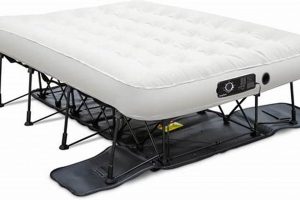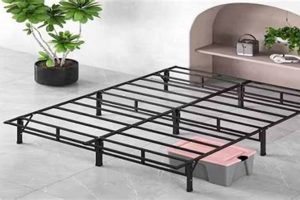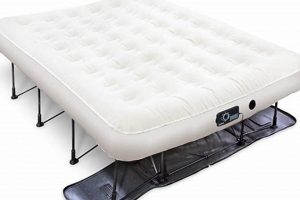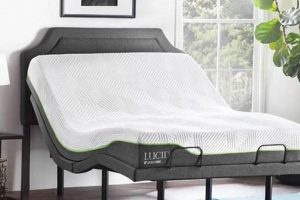A mismatch in dimensions between a mattress and a bed frame can present immediate challenges. A mattress designed to fit a specific bed frame size will not properly fit a frame of a different size. For example, a mattress intended for a larger frame, like a queen, will not sit correctly on a smaller full-size bed frame.
Understanding the standardized dimensions of mattresses and bed frames is crucial for ensuring proper support and comfort. Using the correctly sized frame is important for the longevity of the mattress and ensures warranty validity. Historically, bed frames and mattresses have been manufactured in standard sizes to promote compatibility and ease of purchase for consumers.
This article will delve into the specific dimensional differences between queen and full-size bed frames and mattresses. It will examine the potential consequences of attempting to pair mismatched sizes. Furthermore, it will offer guidance on accurately measuring bed frames and mattresses, and address common scenarios where size compatibility becomes a concern.
Tips Regarding Mattress and Frame Compatibility
Selecting the correct size bed frame for a mattress is essential. Attempting to fit a larger mattress, such as a queen, onto a smaller frame, such as a full, can lead to several problems. The following tips offer guidance on ensuring proper fit and avoiding potential issues.
Tip 1: Verify Dimensions. Prior to purchase, measure both the mattress and the bed frame. Queen mattresses typically measure 60 inches wide by 80 inches long, while full mattresses are 54 inches wide by 75 inches long. Discrepancies in these measurements will confirm incompatibility.
Tip 2: Consult Manufacturer Specifications. Refer to the manufacturer’s specifications for both the mattress and the bed frame. These documents provide precise dimensions and recommended frame types. Deviation from these recommendations can compromise the integrity of both products.
Tip 3: Consider Frame Support Structure. Full and queen bed frames differ not only in size but also in their support structure. A full frame may lack the central support required for a queen mattress, potentially causing sagging or uneven wear.
Tip 4: Assess Overhang. Placing a queen mattress on a full frame will result in overhang. This overhang poses a safety hazard, increases the risk of damage to the mattress edges, and can make the bed unstable.
Tip 5: Research Adapter Options (With Caution). While some individuals explore adapter options to accommodate a queen mattress on a smaller frame, these solutions are often temporary and may compromise the mattress’s support and warranty. Proceed with caution and consider professional consultation.
Tip 6: Prioritize Proper Fit. A properly sized bed frame is important for both comfort and longevity. It ensures optimal support and distributes weight evenly across the mattress, preventing premature wear and tear. In the long run, proper fit saves costs and minimizes inconveniences.
Tip 7: Evaluate Space Constraints. Its important to consider the dimensions of the room where the bed will reside. While a queen mattress might seem desirable, a full size might be more appropriate for smaller spaces, providing better room layout. Ensure the selected frame and mattress are both suitable for the room’s dimensions.
Proper sizing between bed frame and mattress is not merely a matter of convenience, but a fundamental aspect of ensuring restful sleep, maximizing mattress lifespan, and maintaining a safe sleeping environment. Accurate measurements and informed purchase decisions are critical.
The subsequent sections will explore alternative solutions for space optimization and detail factors to consider when selecting a bed frame that will adequately support the chosen mattress size, leading to a more satisfying and lasting investment.
1. Size incompatibility
The proposition of fitting a queen mattress to a full bed frame is fundamentally challenged by size incompatibility. A queen mattress, standardized at 60 inches in width and 80 inches in length, exceeds the dimensions of a full-size bed frame, which typically measures 54 inches wide and 75 inches long. This dimensional difference creates a situation where the mattress overhangs the frame, rather than being properly supported within its boundaries.
This size incompatibility has practical implications. The lack of support on the overhanging edges of the mattress accelerates wear and tear, especially along the perimeter. The reduced support impacts the user’s comfort and may lead to uneven wear, reducing the lifespan of the mattress. For instance, a person consistently sitting on the edge of a queen mattress atop a full frame will experience that edge deforming more quickly than the rest of the mattress due to inadequate support. This will create an uneven sleeping surface, reducing the sleeping comfort.
Furthermore, attempting to force this combination introduces potential safety concerns. The instability caused by the overhang can lead to the mattress shifting or even falling off the frame, particularly with added weight. Addressing size incompatibility is therefore not simply about aesthetics; it is a fundamental requirement for proper mattress support, longevity, and user safety. Adhering to established size standards for mattresses and bed frames ensures optimal functionality and extends the useful life of both components.
2. Structural Integrity
Structural integrity, referring to the ability of a bed frame to withstand loads and maintain its shape and functionality, is fundamentally compromised when a queen mattress is placed on a full-size frame. The intended design of a full frame anticipates a specific weight distribution and dimensions, factors which are significantly altered by the larger queen mattress.
- Frame Overload
A full-size bed frame is engineered to support the weight of a full-size mattress and its occupants. Placing a queen mattress, which is both heavier and wider, exceeds the design capacity. This overload can cause bending, warping, or even breakage of the frame over time. An example includes the central support beam of a full frame bowing under the excess weight, leading to uneven mattress support and a shortened frame lifespan.
- Compromised Joint Stability
Bed frames rely on the integrity of their jointswhere the side rails connect to the headboard and footboardto maintain overall stability. The additional stress from a queen mattress can weaken these joints, leading to wobbling or eventual separation. The connecting hardware, such as screws or bolts, may loosen or strip, rendering the frame unstable and potentially hazardous. This could lead to unexpected collapse.
- Inadequate Support Surface
Full-size bed frames provide a specific surface area designed to support a full-size mattress evenly. When a queen mattress is used, a portion of the mattress extends beyond the frame’s support surface. This overhang creates uneven pressure points and reduces the overall stability of the sleeping surface. This can cause discomfort and, in extreme cases, damage to the mattress itself, such as compressed springs along the unsupported edges.
- Increased Risk of Failure
The combined effects of frame overload, compromised joint stability, and inadequate support surface significantly increase the risk of structural failure. This failure can manifest as a sudden collapse of the bed, posing a safety risk to the occupants. Furthermore, the compromised structural integrity can reduce the mattress’s lifespan, as it is not being supported properly.
In conclusion, attempting to accommodate a queen mattress on a full-size bed frame introduces fundamental challenges to the frame’s structural integrity. The resulting stresses and imbalances can lead to premature wear, compromised stability, and potential safety hazards. Adhering to appropriate size pairings ensures the longevity and safe operation of both the bed frame and mattress.
3. Edge support
The compatibility between a mattress and bed frame directly impacts edge support, an important factor related to sleep quality and mattress longevity. Edge support refers to the structural reinforcement along the perimeter of a mattress, designed to prevent sagging and provide a stable surface when sitting or sleeping near the edge. The mismatched dimensions between a queen mattress and a full-size bed frame compromise this support, causing the mattress to overhang the frame’s perimeter. This lack of support causes the mattress edges to degrade prematurely.
The practical consequences of diminished edge support are varied. Individuals may experience a feeling of rolling off the bed when sleeping near the edge. Sitting on the side of the bed for dressing or other activities becomes less stable and more difficult. Over time, the unsupported edges can deform permanently, reducing the overall usable sleeping surface and potentially affecting spinal alignment. For example, a queen mattress placed on a full frame may exhibit a noticeable sag along the sides after only a few months of use, particularly if the occupants frequently sit or sleep near the edges.
Proper edge support is an important characteristic of a quality mattress, contributing to both comfort and durability. Attempting to use a queen mattress on a smaller full frame defeats this design consideration. By understanding this, consumers can avoid premature wear and maintain the intended structural integrity of their mattress. Using correctly sized support can lead to more restful sleep and a prolonged mattress lifespan.
4. Weight distribution
The proper distribution of weight across a bed frame and mattress system is crucial for both support and longevity. A queen mattress, designed to distribute weight over a larger surface area, experiences compromised weight distribution when placed on a smaller, full-size frame. This mismatch creates concentrated stress points, leading to uneven wear and potential damage to both the mattress and the frame.
The central premise of weight distribution relates to the surface area over which a given load is spread. A full-size frame provides less surface area than a queen-size frame. Placing a queen mattress on a full frame forces a significant portion of the mattress weight to concentrate on the area directly supported by the frame, while the overhanging portions receive little or no support. This can lead to sagging in the unsupported areas and accelerated wear in the supported areas. For example, if two individuals sleep on a queen mattress resting on a full frame, the area directly above the full frame will compress more rapidly than the edges, creating an uneven sleeping surface over time. This unevenness can manifest as discomfort or even contribute to back pain.
Effective weight distribution ensures even wear and maximizes the lifespan of a mattress and frame. When a queen mattress is forced onto a full frame, the resulting uneven distribution compromises both the frames structural integrity and the mattress’s support capabilities. Understanding this interconnected relationship is vital for ensuring optimal sleep comfort, preventing premature wear, and maintaining a safe and supportive sleeping environment. Choosing the appropriate frame size for the mattress is therefore an essential investment in both comfort and durability.
5. Warranty voidance
Warranty voidance is a significant consideration when evaluating the compatibility of a queen mattress with a full-size bed frame. Mattress warranties often contain specific clauses regarding proper usage, including the requirement for adequate support and the use of an appropriately sized frame. Deviation from these requirements can invalidate the warranty, leaving the consumer responsible for repair or replacement costs should issues arise.
- Improper Support Structures
Mattress warranties typically stipulate that the mattress must be used with a supportive frame that provides adequate and even support across its entire surface. Placing a queen mattress on a full frame, which is smaller and may offer less support, violates this requirement. The overhang and uneven weight distribution can cause premature wear and tear, such as sagging or compression of the mattress core. If such damage occurs due to improper support, the manufacturer is likely to deny warranty claims.
- Weight Capacity Exceedance
Bed frames, including full-size frames, are designed with specific weight capacity limits. Placing a larger and potentially heavier queen mattress on a full frame can exceed these limits, leading to structural damage to the frame itself. This damage, in turn, can contribute to uneven support for the mattress. Most warranties explicitly exclude coverage for damage resulting from exceeding weight limits, further increasing the risk of voidance.
- Deviation from Manufacturer Guidelines
Mattress and bed frame manufacturers provide specific guidelines regarding compatible sizes and usage. Intentionally disregarding these guidelines by using a queen mattress on a full frame constitutes a misuse of the product. Warranty agreements often include clauses that exclude coverage for damage resulting from misuse or improper handling, thus nullifying the warranty if the mattress is used in a manner contrary to the manufacturer’s instructions.
- Lack of Evidence of Proper Use
In the event of a warranty claim, the consumer may be required to provide evidence of proper mattress and frame usage. This can include photographs or documentation demonstrating that the mattress was used with an appropriate frame and in accordance with the manufacturer’s guidelines. The absence of such evidence, particularly in cases where a queen mattress has been used on a full frame, can provide grounds for warranty denial.
The potential for warranty voidance represents a critical financial consideration. While attempting to use a queen mattress on a full frame might seem like a cost-saving measure in the short term, the risk of invalidating the mattress warranty can lead to substantial expenses in the long run. Adhering to manufacturer guidelines regarding proper frame size ensures warranty coverage and protects the consumer’s investment in their sleep system.
6. Safety hazard
The dimensional mismatch inherent in attempting to place a queen mattress on a full-size bed frame creates significant safety hazards. The instability resulting from this configuration poses risks to both the user and the structural integrity of the furniture itself.
- Tipping and Instability
The overhang of a queen mattress beyond the support structure of a full frame creates an unbalanced system prone to tipping. Concentrated weight on the unsupported edges can cause the entire bed to become unstable, particularly when individuals sit or lie near the perimeter. This risk is amplified when the bed is placed on smooth or uneven flooring. An example is a child climbing onto the edge of such a bed, causing it to unexpectedly tilt, potentially leading to injury.
- Risk of Falls
The increased bed height resulting from a queen mattress not fully seated on a full frame, combined with the lack of edge support, elevates the risk of falls, especially for children, the elderly, or individuals with mobility issues. Getting into or out of bed becomes more precarious, as the mattress may shift or collapse slightly under weight. Furthermore, the uneven sleeping surface can contribute to accidental falls during sleep. For instance, an elderly person could easily misjudge the edge of the bed during the night, resulting in a fall and potential injury.
- Structural Failure
The sustained stress from supporting a queen mattress can compromise the structural integrity of a full-size bed frame. Over time, the frame may weaken, leading to component failure such as broken slats, bent supports, or detached joints. This failure can occur suddenly and without warning, causing the mattress to collapse and potentially injure anyone on or near the bed. Imagine the sudden collapse of the bed frame during the night due to the sustained weight of the queen mattress, potentially causing harm to the sleeper.
- Obstructed Movement and Egress
The extended footprint of a queen mattress on a full frame can obstruct movement within a bedroom and impede egress in the event of an emergency. The overhang can create tripping hazards and reduce the available space for navigating around the bed. In confined spaces, this obstruction can hinder quick evacuation during a fire or other emergency. For example, the extended mattress might block access to a doorway or window, preventing a timely escape.
These safety considerations underscore the importance of using appropriately sized mattresses and bed frames. The potential for instability, falls, structural failure, and obstructed egress demonstrates that the convenience of using an existing full frame does not outweigh the inherent risks associated with placing a queen mattress on it. Proper sizing and structural support are fundamental for creating a safe and functional sleeping environment.
Frequently Asked Questions
The following questions address common concerns and misconceptions regarding the compatibility of queen mattresses and full-size bed frames. These responses provide informative insights to ensure informed decision-making.
Question 1: Is it physically possible to place a queen mattress on a full bed frame?
While it may be physically possible to balance a queen mattress atop a full bed frame, the overhang compromises support and stability. The mattress extends beyond the frame’s perimeter, creating an unstable and potentially hazardous situation.
Question 2: Will using a queen mattress on a full bed frame damage the mattress?
Yes, using a queen mattress on a full bed frame can lead to premature wear and tear. The unsupported edges of the mattress are prone to sagging and deformation, reducing the mattress’s lifespan and potentially voiding the warranty.
Question 3: Can adapter kits compensate for the size difference between a queen mattress and a full bed frame?
Adapter kits may offer a temporary solution, but they often fail to provide adequate support and stability. These kits may not effectively distribute weight, and their long-term effectiveness is questionable. Consultation with a professional is advisable.
Question 4: Does using a queen mattress on a full bed frame affect sleep quality?
Yes, the lack of proper support and the potential for uneven weight distribution can negatively impact sleep quality. The unstable sleeping surface and the risk of rolling off the bed contribute to discomfort and disturbed sleep patterns.
Question 5: What are the potential safety risks associated with using a queen mattress on a full bed frame?
The primary safety risks include instability, increased risk of falls, and potential structural failure of the bed frame. The unbalanced system can tip or collapse, causing injury to the occupants.
Question 6: Will placing a queen mattress on a full bed frame void the mattress warranty?
Most mattress warranties require the use of a properly sized and supportive frame. Using a queen mattress on a full frame often violates these requirements, potentially voiding the warranty and leaving the consumer responsible for any repairs or replacements.
These FAQs highlight the importance of understanding the dimensional differences and the potential consequences of using mismatched mattresses and bed frames. Prioritizing proper fit ensures comfort, safety, and the longevity of both the mattress and the frame.
The subsequent section will provide guidance on selecting the correct size bed frame for a given mattress and discuss alternative solutions for optimizing bedroom space without compromising support or safety.
Conclusion
The preceding analysis has demonstrated the inherent incompatibilities of attempting to accommodate a queen mattress on a full-size bed frame. Dimensional mismatches, structural support limitations, potential safety hazards, and the risk of warranty voidance collectively indicate that such a pairing is inadvisable. The compromised weight distribution and edge support not only reduce sleep quality and mattress lifespan but also pose risks to the structural integrity of the bed frame itself.
Prioritizing correct sizing for both mattresses and bed frames is essential for ensuring long-term comfort, safety, and product longevity. Making informed purchasing decisions, guided by accurate measurements and adherence to manufacturer guidelines, represents a sound investment in both individual well-being and the durability of household furnishings. While the temptation to utilize existing components might exist, the drawbacks outweigh the benefits, and resources should be allocated towards acquiring appropriately sized equipment.




![Best Queen Futon Frame and Mattress Sets: [Year] Guide Organic & Natural Mattress Buyer’s Guide: Non-Toxic Sleep Solutions Best Queen Futon Frame and Mattress Sets: [Year] Guide | Organic & Natural Mattress Buyer’s Guide: Non-Toxic Sleep Solutions](https://mattressworldpa.com/wp-content/uploads/2025/07/th-3093-300x200.jpg)


